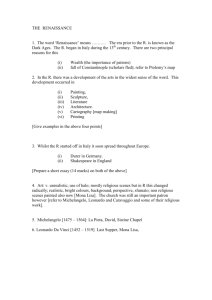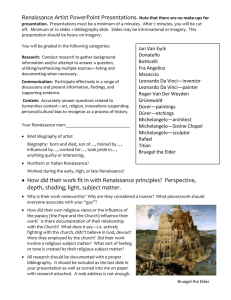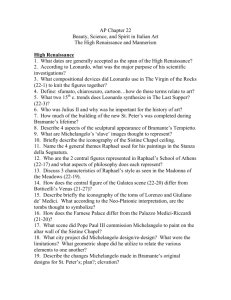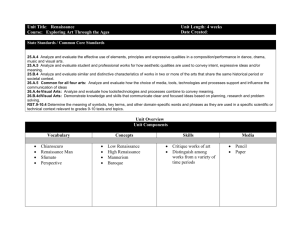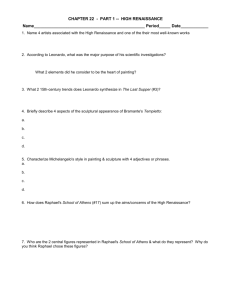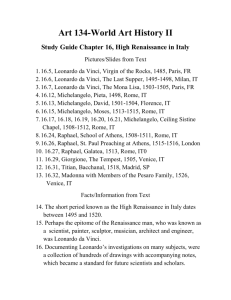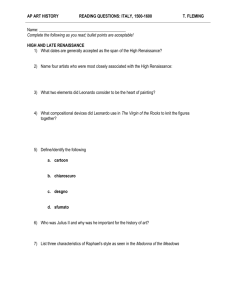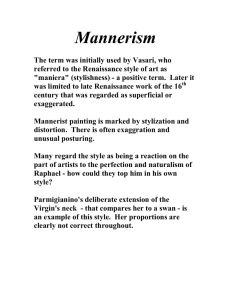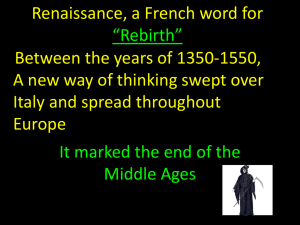View/Open - Digitised Collections
advertisement
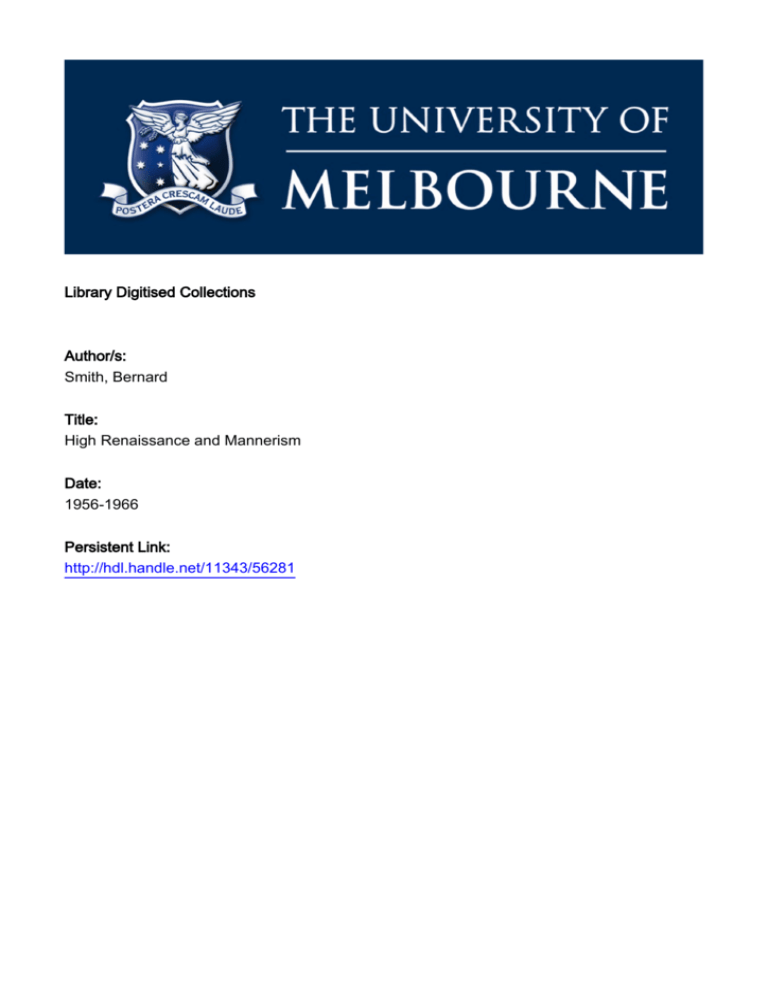
Library Digitised Collections Author/s: Smith, Bernard Title: High Renaissance and Mannerism Date: 1956-1966 Persistent Link: http://hdl.handle.net/11343/56281 High Renaissance and Mannerism In this lecture I want to survey the styles which we describe as High Renaissance and Mannerism; he period of High Renaissance usually accepted is that from the completion of the Last Supper by Leonardo in 1498 until the Sack of Rome by the troops of the Emperor Charles V of Spain in 1527. The Mannerist phase covers the remainder of the century that is from 1527 until 1600; though as with all historical periods there is a considerable overlapping. We might begin our consideration of the High Renaissance style by considering briefly Heinrich Wölfflin’s famous description of it. In his Principles of Art History he distinguished it from the baroque style of the 17th century by means of five pairs of concepts. High Renaissance art he claimed was (1) linear. That is to say line is ‘the guide of the eye’. Objects and volumes are isolated by line. (2) Planar. Depth is established by a sequence of planes parallel to the picture plane. This planar style made its appearance at the moment when foreshortening and spatial illusion had been completely mastered. (3) High Renaissance composition is closed. That is to say, each work of art is conceived as a finite whole, the picture itself is self-contained; we do not perceive a high renaissance work of art as a fragment of the world but as a complete world in itself. (4) High Renaissance composition consists of a unity of independent parts; each part of a composition, that is to say retains a certain unity and independence of its own. (5) And this follows from the combined effect of the proceeding four, and is in a sense a summary of them, High Renaissance art is characterised by an absolute clarity. Each part of the composition is clearly depicted and the composition as a whole is clearly and unambiguously stated. These qualities may be observed in the work of all the great masters of the High Renaissance during the years around 1500-10; in Michelangelo, Bramante, Raphael, and Leonardo. Michelangelo, as a young man, came into direct contact with the two most powerful intellectual currents of the time: neo-Platonism and Savonarola. He began life as an apprentice in the workshop of Ghirlandaio* who taught him fresco painting but his training as a sculptor was due to the personal interest of Lorenzo de Medici; for Lorenzo allowed him to study the antique sculpture which had been brought together in the Medici garden. Under Lorenzo’s patronage he came into direct contact with the Neo-Platonic circle around Lorenzo: and neo-Platonic thought with its blend of paganism and Christianity exercised a profound impact upon his art. In 1492 however Lorenzo died and Florence came under the control of that remarkable Dominican monk, Girolamo Savonarola*. Savonarola preached in fiery, apocalyptic language against the neo-paganism f Lorenzo’s court and called for radical reforms within the church. Under the theocratic democracy which he established in 1494-5 the citizens of Florence turned to a more austere religious life in which all art, luxury ,a d neoplatonic thought was severely questioned. But Savonarola’s triumph was short-lied. His severities made him many enemies and coming into direct conflict with the Borgia Pope Alexander VI, the most notorious and immoral of all the Popes, which is saying a good deal, and a most generous patron of the arts, Savonarola was excommunicated in 1497, and in 1498 tortured, hanged and burnt as a heretic in the market place of Florence. Michelangelo, whole a young man in his twenties lived through these momentous events, in which the religious wars and persecution of the sixteenth century were luridly foreshadowed. Both Neo-platonic thought and the teachings of Savonarola so violently opposed to neo-Platonism exercised a profound influence upon his mind and art. Indeed they left him a genius divided against himself: Neo-Platonism had taught him to accept pagan antiquity; and his early love-poems reflect his belief in the beauty of the material world; but his Christian faith was deeply stirred by Savonarola; so that his art and life reveals a deep-seated dualism; a conflict between the classical and Christian elements of his imagination. His first major work is his Pieta*, completed in 1499, and placed in St Peters. First let us note that its style exemplifies Wölfflin’s categories; that is to say, it is undoubtedly linear; secondly, it is designed so that the axis of vision is frontal, despite the magnificent contraposition of the figure of Christ, changing its direction so subtly that we do not notice any incongruity of the adult male across the lap of the virgin, despite this we can say that the composition consists as a whole of two main planes, the plane established by the virgin’s torso and bowed head behind. Thirdly, the composition is closed, it feels complete in itself. Most o the lines of composition turn back into the composition itself: the bowed head of the virgin turns towards her son, the fingers of her outstretched hand turn back in a gesture both of display and acceptance. It is only the head of the dead Christ facing outward which indicates that the Pieta does not completely conform to Wölfflin’s principles. Fourthly it is a unity of independent parts, both the body of Christ and the Virgin though forming a complex triangular unity , are themselves self-contained expressive units, and finally we may say that the whole design is characterised by clarity. Turning from style to the expression of the Pieta: we may note that the mood of High Renaissance are is noble, calm and solemn. The mother of God* betrays no emotion. Like the Apollo on the East Pediment of the Temple of Zeus at Olympia, she is beyond human frailty. As Wölfflin his put it ‘this is the sensibility of the Cinquecento’. In architecture the High Renaissance sensibility first revealed itself in the work of Bramante. In Bramante’s Tempietto at S. Pietro* in Monorio completed in 1502, on the traditional site of St Peter’s martyrdom, we have The centrally planned church* made fashionable by Alberti’s writings. Beautifully and simply proportioned it consists of two concentric cylinders surmounted by a dome. It was modeled upon circular Roman temples such as the Temple of Vesta at Tivoli.* The Tempietto, though quite tiny, is important also because its plan foreshadows the first plan for St Peters Basilica** which Bramante completed for Pope Julius II in 1506. It was Julius II who attracted Michelangelo, Bramante, Leonardo and Raphael to Rome and made it the leading art centre of the world in the early years of the sixteenth century. In painting, the ideals of the High Renaissance were most perfectly expressed in the work of Raphael. Trained in the workshop of Perugino (Delivery of the Keys to St Peter, Perugino*) Raphael’s first mature painting is his Betrothal of the Virgin* (or Sposalizio) of 1504. Here Wölfflin’s principles of linearity, planar recession, closed composition, the unity of independent parts, and absolute clarity are exquisitely demonstrated. Note the beautiful ordering of space by means of centralised perspective; and the separation of the foreground figures, which confront one another in two groups beautifully balanced, from the architectural background.* Note also the temple so reminiscent of Bramate’s Tempietto. The paintings, however, which most perfectly express the ideas of High Renaissance art are the frescoes which Raphael pained for Julius II in the Vatican in a suite o small rooms or stanzé. The most important paintings are contained in the Stanza della Segnatura, which housed the Pope’s private library. The two principal frescoes in the Stanza della Segnatura represent Philosophy and Theology; and have been given the names School of Athens and Disputa. Let us consider first the Philosophy, or the School of Athens, 1510-11. It represents the philosophers of the ancient world led by Plato and Aristotle who hold the composition together at the centre. Aristotle,* the practical, natural philosopher with his hand stretched forward, gestures toward the earth; Plato, the idealist, points upwards. But the picture itself is a whole encyclopedia of gestures which artists through engravings after Raphael were to use for centuries. To the right of Plato is Socrates counting off the points of his argument on his fingers, on the steps, stretched out like any Roman beggar lies Diogenes. And below in he foreground a group around Pythagoras, and a group of Geometers, Euclid and Ptolemy to the right. Note the enormous scale o the architecture, a scale almost resembling St Peter’s itself: and Vasari at least claimed that the architectural background was painted by Bramante. The Theology or Disputa depicts the four doctors of the church: Jerome, Gregory, Ambrose and Augustine, and around them the faithful in contemplation. Above the faithful is the figure of Christ showing his wounds attended by the virgin and ST John, and above him again, God the father in benediction, below him the Dove. By means of carefully defined gestures Raphael leads the eye into the picture, identifying each figure in the complex group yet linking it with the rest. The beginning of this language of noble gesture began of course with the interlocked groups of Leonardo’s Last Supper;* and the Stanza della Segnatura frescoes may be seen as Raphael’s development of Leonardo’s new visual-gesture language. On the other hand the dynamic energy and vigour of Raphael’s drawing reveals how much he had learned from Michelangelo’s paintings on the Sistine ceiling which were begun in 1508, the year before the Stanza frescoes. After his Pieta, Michelangelo had carved his extremely beautiful Bruges Madonna and Child for Notre Dame Bruges. The virgin wears a slightly sulky expression ad the Child looks petulant, but the child standing between the virgin’s knees was an innovation and the new vertical accents provide an air o grandeur quite different from Quattrocento art. Between 1501 and 1504 he carved his enormous David* which Wölfflin calls the final expression of Florentine fifteenth century naturalism, for indeed compared with wither Donatello’s David* or Verrochio’s David* it makes use of a simpler and more naturalistic pose; and its stance and musculature may be compared with Polyclitus’s Doryphorous,* except that here, for all its apparent naturalism, the subtle contrapostal twists of the body are so much more complex. In 1508 Michelangelo began his most important work, the ceiling of the Sistine Chapel,* for Pope Julius II. The ceiling was to complete the decoration of the pope’s personal chapel which had already been begun during the 140s. The hole ceiling is a simple ad shallow barrel vault which Michelangelo divided up by means of painted architecture. At the top of the roof in alternating large and small panels he painted what are called the Histories: these are a series of events narrated in the old testament, fro the first act of creation, with god dividing the light from the darkness (God creating the sun and moon*) up to the Drunkenness of Noah. Surrounding the small panels in every case are four figures of nude youths these are known as the Slaves (or Ignudi). Below them are the prophets and sibyls, and below the again the Ancestors of Christ. The whole conception clearly reflects those neo-platonic thought currents in Lorenzo de Medici’s circle in Michelangelo’s youth. From that circle Michelangelo inherited an ideal of beauty which was based upon the beauty of the nude human body. As Anthony Blunt puts it: ‘The iconographic scheme of the Sistine frescoes is based on the most erudite theology, but the forms in which it is clothed are those of the pagan gods.’ The blending of the pagan and Christian ideal characteristic of neo-Platonism is nowhere better seen than in the panel depicting the Creation of Adam. Sir Kenneth Clark has noted the similarity of Adam’s pose to that of the Dionysius* from the Parthenon pediment; and yet how different he writes is the Adam from Dionysis: ‘It is the difference between being and becoming. The Dionysius, in its timeless worked, obeys an inner law of harmony; the Adam gazes out to some superior power which will give him no rest’. Eve, under the left arm of God, still unborn but here given the chance to look at what the future holds for her—clearly has the gravest doubts about the whole creation business and the part she his expected to play in it. The series proceeds through the Fall of Man*, in which we may note that Michelangelo uses the barest of landscape motifs as did his great forerunners Giotto and Massaccio. Indeed the expulsion is clearly influenced by Massaccio’s expulsion;* and ends with the Drunkenness of Noah, which indicates man, in the neo-platonic cycle, at his furthest remove from God. The Sibyls are, of course, the ancient prophetesses who here foretell the coming of Christ. The Delphic Sybil,* though seen fill face is a miracle of contapostal composition. As with so many of Michelangelo’s creations the conception is not static but of moment restrained and held for a moment; so that the figures generate a feeling of intense energy. In his ten slaves* Michelangelo exploits all the possibilities of contrapposto in order to use the nude human form as an expressive symbol. It is in these slaves that his neo-platonic ideal of beauty based upon the nude human form is most fully expressed. Let us now turn briefly to the High Renaissance in Venice. Here the division between the early and the High Renaissance is less marked and the Venetians exploited oil techniques of painting more thoroughly than the painters of Florence and Rome. They Begin to develop an art which is concerned increasingly with harmonious colour rather than with beauty of form. We have already noted Giovanni Bellini’s* use of colour as an aid to evoking a generalised mood in keeping with the subject in his Agony in the Garden (The Entombment).* This was developed by Giogione, the first Venetian painter of the High Renaissance. When we look at his Tempest* (Accademea?) painted about 1505 we will find some difficulty in applying the Wölfflinian categories of High Renaissance art, linearity, planar recession, closed composition, absolute clarity and so forth with confidence. Indeed, it cannot be said that either the meaning or the structure of the painting are clear. Giorgione is not depending so much upon clear formal structure for his effect it upon his capacity to evoke a mood by means of the Leonardoesque technical devices of Chiaroscuro and sfumato and by a generalised colour tonality of green and blue. It is a threatening mood in which the strange lurid beauty of nature seen in the twilight of the storm is somehow linked with the two enigmatic figures, the young soldier and the nude young mother, in the foreground. But we cannot quite say what Giorgione means; the fascination of the picture lies in its ambiguity rather than in its clarity; event eh name Tempesta is an invention. And yet we feel that figures and landscape are so wonderfully united; so that here we have one of the most perfect embodiments in art of what John Ruskin called the pathetic fallacy, that is, the use of landscape as a mirror or reflection of human emotion. Giorgine’s neo-pagan sinuosity and luxury of colour is carried on in the work of his greatest follower Titian. Like the Florentine’s, like Botticelli, Leonardo, Michelangelo, Titian is more than half in love with the pagan world of antiquity, but his approach is less intellectual less formal, more sensuous, more purely pagan than theirs. As Panofsky has so neatly put it. ‘Where Florentine art is based on design, plastic firmness, and tectonic structure, Venetian art is based on colour, pictorial succulence and musical harmony’ (Bacchus and …, Nymph and Shepherd, late work, Vienna). I want to turn now to a brief consideration of Mannerist Art, which is now used to describe a good deal but not all of the art of the period between 1520 and 1600. The term has only been used in this sense during the present century; and has been developed from the Italian word maniera which was used by Vasari to describe the art which developed out of the style of the High Renaissance masters, Leonardo, Raphael, and Michelangelo, but also away from that art in that it deliberately flouted the classical rules, and was based upon intellectual preoccupations, rather than upon visual perception and that scientific naturalism from which High Renaissance art has grown. Neo-platonic thought had emphasised that ideal beauty is not achieved simply by copying nature faithfully; but is rather the reflection of the divine in the material universe, and further that the artist by the exercise of his divine power of the imagination might realise that beauty in his works. Both the work and the thoughts of Michelangelo had much to do in shifting the emphasis from an ideal based on visual perception, to an idea based upon the ‘inner vision’ of the artist. ‘Tell me love’ writes Michelangelo in a love sonnet written about 1530 ‘I beseech thee, if my eyes truly see the beauty which is the breath of my being, or if it is only an inward image I behold when, wherever I look, I see the carven image of her face.’ The new ‘anti-classical’ mannerist art based increasingly upon ‘inner vision’ rather than perception first appears after 1520 in the work of three painters, Rosso, Pontormo and Parmigianino all three of whom possessed what we should today call a neurotic temperament. It is significant that both Rosso and Pontormo were pupils of Andrea Del Sarto, whom the 19th century revered as the perfect painter because the rather eclectic beauty of his work embraced the varied achievements of Leonardo, Raphael and Michelangelo, but n comparison with the work of any of those masters Del Sarto’s ideal beauty is surely a cold, passionless and artificial beauty. It is not surprising that his students began to deliberately break the classical rules in order to achieve new forms of expression. This new anti-classical trend may be observed in Rosso’s Decent from the Cross of 1521.* The composition is more open, more spidery than the firm triangles of the High Renaissance; in place of the high classical calm there is violent gestured and signs of agitation, the draperies are sharp and brittle, quite unlike the smooth flowing transitions of Leonardo’s sfumato. His friend Pontormo reveals the introspective side of Mannerism. Let us compare his sensitive drawing of a young girl of 1526* with Leonardo’s portrait drawing of … (?) In the one classical calm and confidence; in the other a shrinking uncertainty, a withdrawal into self. This, while anti-classical, was, it must be remembered, nevertheless an extension of the expressive range of art. The stylistic and expressive qualities of early mannerism is best seen however in the work of Parmigianino,* particularly in his Madonna with the Long Neck, in the Uffizi. He had been greatly influenced by Raphael’s Madonnas,* such as the Sistine Madonna (after 1513) with its classical calm and amplitude of form. But he has given Raphael’s art a strong ant-classical twists: proportions are lengthened so that forms are attenuated; perspective is exaggerated, and there is great discrepancies of scale between the virgin and her attendants. Again a feeling of disquiet is produced by the column beautifully finished, but like a ruin supporting nothing, or* the enigmatic gentleman who opens a great scroll but instead of reading it turns his head in the opposite direction. Quarrelsome and neurotic Parmigianino led a turbulent life, dying like Raphael himself at the age of 37. Vasari’s description of him is well worth quoting: ‘Having his thoughts filled with alchemy…, he changed from the delicate, amiable and elegant person that he was, to a bearded long-haired, neglected, and almost savage or wild man… He was interred naked, as he had wished, and with a cross of cypress placed upright on his breast in the grave’. But his adjusted and attenuated style set an example, spread widely by means of engravings, through Italy and Northern Europe. The later work of Michelangelo was also one of the great formative influences of the Mannerist style in painting, sculpture and architecture. In painting, most notably in his Last Judgment,* painted between 1534 and 1541, upon the wall behind the high altar of the Sistine Chapel for Pope Paul III. This, as Anthony Blunt puts it, ‘is the work of a man shaken out of his secure position, no longer at ease with the world, and unable to face it directly’. Instead of the lithe beauty of Adam we have bodies heavy, lumpish, ugly. Nor is there any longer any logical space, no true perspective, nor typical proportions. It reveals indeed how deeply Savonarola’s questioning of the neoplatonic ideals of his youth had entered into Michelangelo’s imagination. Indeed at this time Michelangelo belonged to a group called the ‘spirituali(?)’ which though unwilling, as Luther was to break entirely from the Papal supremacy, nevertheless urged internal reform in the Roman Catholic Church. This reform party included Vittoria Colonna with whom he fell ardently in love with and to whom he wrote many sonnets, at the age of sixty. She was forty-seven when first they met. But there was no erotic liaison: for Vittoria, at least, the attraction was entirely spiritual. When he was approaching seventy she suggested gently that it was time that they ceased corresponding, though the neo-platonic friendship and their common spiritual interests continued to nite them. A year after he had completed the Last Judgement, Vittoria write to him from the convent of Viterbo where she had become a nun, ‘Noble Michelangelo if we are to keep on writing to each other, I should have to neglect the chapel of St Catherine here forego my meting with the company of the sisters here; while you would have to interrupt your work on the Pauline Chapel’. Not only the spiritual circle around Vitoria Colonna, but the disastrous times themselves undoubtedly played a part in Michelangelo’s spiritual crisis. By 1530 the attempts of the Papacy to form a powerful secular state in Italy had ailed. The Reformation had split the Church in two, Italy had been invaded by the French and the Spanish. The great sack of Rome by the Imperial troops in 1527 was the greatest blow of all. Financial disorder added to the confusion. No social or economic basis remained to support that clear, balanced, and impersonal art of the High Renaissance. It is of course unwise to attribute the mannerist style directly to these social and economic changes. There was bound to have been a change whatever the climate of society; for art had reached a point of perfection from which it had to depart. Nevertheless, the times contributed to the success of the new style. In the Last Judgement Christ appears as a stern judge come to judge Blessed and Damned alike: the figure is an awe-inspiring example of that quality called terribilita, (akin to our idea of the sublime) for which Michelangelo was famous among his contemporise. Below Christ we see the Apostle St Bartholomew who was flayed alive; as a suitable attribute he holds a human skin upon which appears the distorted selfportrait of Michelangelo himself. Clearly, in the hands of a Renaissance genius religious art was also becoming a vehicle of self-expression; that assertion of the rights of the individual conscience which had activated Luther and was creating the widening split in the Church. During the second half of the sixteenth century the Mannerist style spread throughout Europe. In Venice it is best exemplified in the work of Tintoretto, a painter of prodigious energy. His last major work The Last Super of 1592* may be compared with Leonardo’s Last Supper.* Highly dramatic figures, attenuated proportions, the mixing of homely domesticity with angels and transcendent radiance, which provides the picture with a heightened and almost neurotic religiosity which is the very antithesis of Leonardo’s ordered solemnity. The last and most famous of the mannerist painters was El Greco. Born in Crete he studied in Venice where he absorbed the lessons of Tintoretto and the Venetian Mannerists. By 1577 he was in Spain, when he painted his fine Assumption* (Agony in the Garden) now at Chicago, still in the Venetian style. His Masterpiece is the Burial of the Count Ogaz of 1586,* wherein we see St Stephen and St Augustine, mysteriously appearing at the death of the holy man and assist at the burial by lowering hum into the grave. Above he is received by Christ and the Virgin above the Blessed. The painting itself is not only a masterpiece of mannerist ‘anti-classical’ principles but also captures remarkably the spiritual energy, the fanaticism and ecstasy of the Spanish counter reformation. References: C. Gould: Introduction to Italian Painting. L. Goldscheider Michelangelo L. Goldscheider Phaidon (Michelangelo) A. Blunt Artistic Theory in Italy W. Friedlander Mannerism and Anti-Mannerism.
